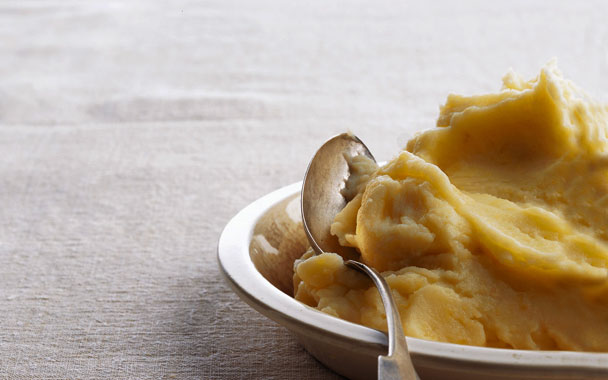What’s New
Nothing. At least that was the assumption in our test kitchen until food editor Shelley Wiseman decided to question every key variable in this stalwart side dish. This included a factor we all thought was a given—how to cook the potatoes. But, for one version, Wiseman baked rather than boiled the potatoes prior to mashing, and it was a revelation: The concentrated, earthy flavor made converts out of most of us. Wrap the potatoes in foil (to preserve tenderness) before putting them in the oven, skin them after they have cooked, and then put them through a ricer. The downside to baking? Some of our testers missed the lighter, more silky texture of potatoes that are boiled before being mashed. So it comes down to choice: How do you like them, really smooth or with a deep potato taste?
Tried & True
Choosing the Right Potato
· When we baked the potatoes before mashing, they were all so good it didn’t seem to matter which kind we chose.
· Yukon Golds were our hands-down favorite for boiled mashed potatoes, with wonderful flavor and creamy texture.
· If you have access to a garden, roadside stand, or farmers market, nothing beats freshly unearthed potatoes. When you don’t, select fresh-looking ones (firm, with no sprouts or green spots) at the store and keep them in a cool, dry place. If the skins aren’t bitter (taste after boiling), you can leave them on before hand mashing.
Mashing
· Rule number one is to mash potatoes while they are still piping hot and to preheat liquids and butter before they are added. Coolness makes the starch in the potatoes firmer, causing a gummy texture.
· Be gentle when you mash and never use a food processor—potatoes respond to rough treatment by becoming gluelike.
· With baked potatoes, the ricer produces the lightest, creamiest mashed potatoes.
· A food mill produces a wonderful texture if the potatoes are boiled; but the drier baked potatoes become slightly gluey when put through the mill.
· Using a hand masher allows you to add butter and hot liquid before mashing, which minimizes the chance of overworking the starch. This is also true of an electric mixer. But both masher and mixer produce lumpier and heavier results than other methods.
· If you leave the skins on, the hand masher is definitely the way to go.
Adding Liquids and Butter
· Whole milk turned out to be the best liquid. Buttermilk contributed too much acidity. Potato cooking water made mashed potatoes that were light and unsatisfying. Cream was too heavy.
· Baked potatoes were drier and required more liquid than boiled potatoes, but they also could absorb more fat, to the delight of the butter lovers among us. Too much butter (more than 1 tablespoon per serving), however, can mask the potatoes’ earthy flavor.
Cleaning Up
· The sooner the better. The colder the starch in mashed potatoes gets, the harder it becomes. A quick scrub right as you finish will save time down the line.



 Pinterest
Pinterest






